Languages of Switzerland
| Languages of Switzerland | |
|---|---|
 | |
| Official languages | The blue areas represent bodies of water |
| Main immigrant languages | Albanian, Bosnian, Bulgarian, Croatian, English, Dutch, Greek, Macedonian, Portuguese, Serbian, Slovenian, Spanish, Tamil, Turkish and Ukrainian. |
| Main foreign languages | English |
| Sign languages | Swiss German Sign Language, French Sign Language, Italian Sign Language[1] |
| Common keyboard layouts |
 |
| Part of a series on the |
| Culture of Switzerland |
|---|
 |
| History |
| People |
| Languages |
| Cuisine |
| Festivals |
| Literature |
|
Music and performing arts |
| Sport |
|
Symbols |
|
The four national languages of Switzerland are German, French, Italian and Romansh.[2] All but Romansh maintain equal status as official languages at the national level within the Federal Administration of the Swiss Confederation.[3]
In 2013, native speakers of German (chiefly Swiss German, though Standard German is also understood) number about 5 million (63.5%); French (mostly Swiss French, but including some Arpitan dialects) number 1.8 million (22.5%); Italian (mostly Swiss Italian, but including Lombard dialects), 645,000 (8.1%); and Romansch, 40,000 (0.5%).[4]
The German region (Deutschschweiz) is roughly in the east, north and center; the French part (la Romandie) in the west and the Italian area (Svizzera italiana) in the south. There remains a small Romansh-speaking native population in Graubünden in the east. The cantons of Fribourg, Bern and Valais are officially bilingual; Graubünden is officially trilingual.
History
The main languages of Swiss residents from 1950 to 2013, in percentages, were as follows:[4]
| Year | German | French | Italian | Romansh | other |
|---|---|---|---|---|---|
| 2013 | 63.9 | 22.5 | 8.1 | 0.5 | 21.7 |
| 2000 | 63.7 | 20.4 | 6.5 | 0.5 | 9.0 |
| 1990 | 63.6 | 19.2 | 7.6 | 0.6 | 8.9 |
| 1980 | 65.0 | 18.4 | 9.8 | 0.8 | 6.0 |
| 1970 | 64.9 | 18.1 | 11.9 | 0.8 | 4.3 |
| 1960 | 69.4 | 18.9 | 9.5 | 0.9 | 1.4 |
| 1950 | 72.1 | 20.3 | 5.9 | 1.0 | 0.7 |
In 2012, for the first time, respondents could indicate more than one language, causing the percentages to exceed 100%[4]
National languages and linguistic regions
German
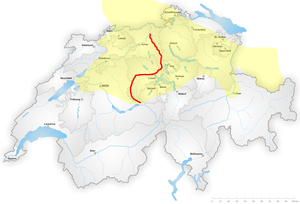
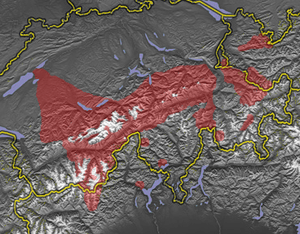
The German-speaking part of Switzerland (German: Deutschsprachige Schweiz, French: Suisse alémanique, Italian: Svizzera tedesca, Romansh: Svizra tudestga) comprises about 65% of Switzerland (North Western Switzerland, Eastern Switzerland, Central Switzerland, most of the Swiss plateau and the greater part of the Swiss Alps).
In 17 Swiss cantons, German is the only official language (Aargau, Appenzell Ausserrhoden, Appenzell Innerrhoden, Basel-Stadt, Basel-Landschaft, Glarus, Lucerne, Nidwalden, Obwalden, Schaffhausen, Schwyz, Solothurn, St. Gallen, Thurgau, Uri, Zug, Zurich).[5]
In the cantons of Bern, Fribourg and Valais, French is co-official; in the trilingual canton of Graubünden, more than half of the population speaks German, while the rest speak Romansh or Italian. In each case, all languages are official languages of the respective canton.
While the French-speaking Swiss prefer to call themselves Romands and their part of the country la Romandie, the German-speaking Swiss used to refer to (and, colloquially, still do) the French-speaking Swiss as "Welsche", and to their area as Welschland, which has the same etymology as the English Welsh (see Walha). In Germany Welsch and Welschland refer to Italy; there, the term is antiquated, rarely used, and somewhat disparaging.
The German-speaking Swiss do not feel like a uniform group: the average German-speaking Swiss feels foremost belonging to Solothurn, St. Gallen, or Uri, and sees himself not speaking Swiss German, but the Baseldytsch (dialect of Basel), Bärndütsch (dialect of Bern) or Züridütsch (dialect of Zurich). This is hardly surprising, however, since there is no single unifying or standard form of Swiss German itself, whereby the term "Swiss German" is simply a generic umbrella term referring in general to all of the various different dialects of German within German-speaking Switzerland. The marked subsidiarity of the Swiss federalism, where many political decisions are taken at municipal or cantonal level, supports this attitude.
Nevertheless, in 2013, 10.1%, or about 830,000 of the Swiss residents speak High German aka Standard German at home, but probably mainly due to German immigrants.[6]
By the Middle Ages, a marked difference had developed between the rural cantons of the German-speaking part of Switzerland and the city cantons, divided by views about trade and commerce. After the Reformation, all cantons were either Catholic or Protestant, and the denominational influences on culture added to the differences. Even today, where all cantons are somewhat denominationally mixed, the different historical denominations can be seen in the mountain villages, where Roman Catholic Central Switzerland abounds with chapels and statues of saints, and the farm houses in the very similar landscape of the Protestant Bernese Oberland show Bible verses carved on the housefronts, instead.
French
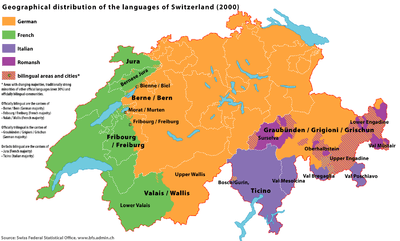
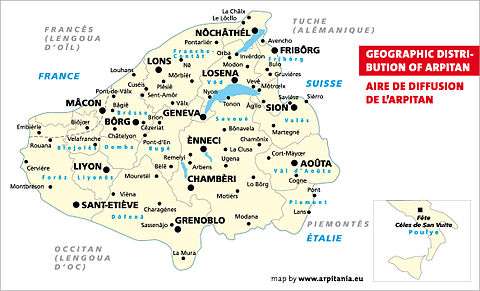
Romandy (French: Romandie, la Suisse romande, German: Romandie, Welschland, Welschschweiz or Westschweiz,[7] Italian: Svizzera romanda) is the French-speaking part of Switzerland. It covers the area of the cantons of Geneva, Vaud, Neuchâtel, and Jura as well as the French-speaking parts of the cantons of Bern (German-speaking majority), Valais (French-speaking majority), and Fribourg (French-speaking majority). 1.9 million people (or 24.4% of the Swiss population) live in Romandy.[8]
Standard Swiss French and the French of France are the same language, with some differences. For example, like some other regions of the French-speaking world, Swiss people (as well as most Francophone Belgians) use septante (seventy) instead of soixante-dix (literally, "sixty ten") and nonante (ninety) instead of "quatre-vingt-dix" ("four twenties and ten"). In the cantons of Vaud, Valais and Fribourg, speakers use huitante (eighty) instead of the Standard French "quatre-vingts" (four twenties).[9] "Sou" is used throughout Romandy for a 5-centime coin, as is "tune" (or "thune") when referring to a 5-Swiss-franc piece.
Historically, the vernacular language used by inhabitants of most parts of Romandy was Franco-Provençal. Franco-Provençal (also called Arpitan) is a language sometimes considered to be halfway between the langue d'oïl (the historical language of northern France and ancestor of French) and Occitan (the langue d'oc, spoken in southern France). Standard French and Franco-Provençal/Arpitan, linguistically, are distinct and mutual intelligibility is limited. Increasingly, Franco-Provençal/Arpitan is used only by members of the older generations.
The term Romandy does not formally exist in the political system, but is used to distinguish and unify the French-speaking population of Switzerland. The television channel Télévision Suisse Romande (TSR) serves the Romande community across Switzerland, is syndicated to TV5, and CanalSat Romande on 2 October.
Italian
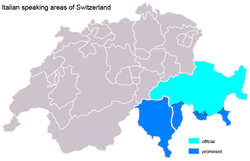
Italian Switzerland (Italian: Svizzera italiana, Romansh: Svizra taliana, French: Suisse italienne, German: italienische Schweiz) is the Italian-speaking part of Switzerland, which includes the Canton of Ticino and the southern part of Graubünden. Italian is also spoken in the Gondo Valley (leading to the Simplon Pass, on the southern part of the watershed) in Valais.
The linguistic region covers an area approximately 3,500 km² and has a total population of around 350,000 inhabitants,[10] with the number of Italophones residing in Switzerland being 545,274 (about 7% of the Swiss population).[11]
The proportion of Italian-speaking inhabitants had been decreasing since the 1970s, after reaching a high of 12% of the population during the same decade. This was entirely because of the reduced number of immigrants from Italy to Switzerland, but gained again during the last decade.[4]
Romansh
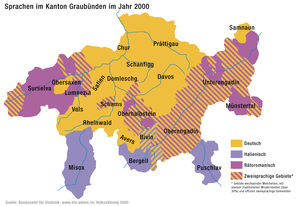
On the cantonal level, Romansh is an official language only in the trilingual canton of Graubünden, where the municipalities in turn are free to specify their own official languages.
Significant communities of Romansh speakers remain in the Surselva, the Sursés/Oberhalbstein valley, the lower Engadin and the Val Müstair.
Romansh has been recognized as one of four "national languages" by the Swiss Federal Constitution since 1938. It was also declared an "official language" of the Confederation in 1996, meaning that Romansh speakers may use their language for correspondence with the federal government and expect to receive a Romansh response – in Romansh Grischun, because the federal authorities use the standardized language exclusively.
Other languages
Besides the official languages and the many varieties of Swiss German, several regional Romance languages are spoken natively in Switzerland: Franco-Provençal and Lombard. About 20,000 Romani speak Sinte, an Indic language. Five sign languages are used: Swiss-German, French, Italian, Austrian,[12] and German.[12]
| Language | 2000[13] Mother Language |
2013[14] Main Language | ||
|---|---|---|---|---|
| Number | % | Number | % | |
| German | 4,639,762 | 63.66% | 4,348,289 | 64.47% |
| French | 1,484,411 | 20.37% | 1,525,003 | 22.61% |
| Italian | 470,961 | 6.46% | 561,857 | 8.33% |
| Romansch | 35,072 | 0.48% | 35,753 | 0.53% |
| Serbo-Croatian | 103,350 | 1.42% | 168,422 | 2.50% |
| Albanian | 94,937 | 1.3% | 176,293 | 2.61% |
| Portuguese | 89,527 | 1.23% | 238,327 | 3.53% |
| Spanish | 76,750 | 1.05% | 150,782 | 2.24% |
| English | 73,422 | 1.01% | 316,830 | 4.70% |
| Turkish | 44,523 | 0.61% | 76,379 | 1.13% |
| Others | 356,444 | 5.28% | ||
| Tamil | 21,816 | 0.3% | ||
| Arabic | 14,345 | 0.2% | ||
| Dutch | 11,840 | 0.16% | ||
| Russian | 8,570 | 0.12% | ||
| Chinese | 8,279 | 0.11% | ||
| Thai | 7,569 | 0.1% | ||
| Kurdish | 7,531 | 0.1% | ||
| Macedonian | 6,415 | 0.09% | ||
| Hungarian | 6,194 | 0.08% | ||
| Swedish | 5,560 | 0.08% | ||
| Czech | 5,444 | 0.07% | ||
| Polish | 5,206 | 0.07% | ||
| Greek | 4,792 | 0.07% | ||
| Vietnamese | 4,226 | 0.06% | ||
| Japanese | 4,100 | 0.06% | ||
| Persian | 3,467 | 0.05% | ||
| Romanian | 3,397 | 0.05% | ||
| Tagalog | 3,019 | 0.04% | ||
| Danish | 2,739 | 0.04% | ||
| Somali | 2,661 | 0.04% | ||
| Finnish | 2,628 | 0.04% | ||
| Slovak | 2,018 | 0.03% | ||
| Slovene | 1,601 | 0.02% | ||
| Bulgarian | 1,579 | 0.02% | ||
| Hindi-Urdu | 1,407 | 0.02% | ||
| Norwegian | 1,361 | 0.02% | ||
| Aramaic | 1,333 | 0.02% | ||
| Korean | 1,202 | 0.02% | ||
| Hebrew | 1,176 | 0.02% | ||
| Tibetan | 1,108 | 0.02% | ||
Latin
.jpg)
To avoid having to translate the name of Switzerland in the four national languages,[15] Latin is used on the coins of the Swiss franc (Helvetia or Confoederatio Helvetica) and on Swiss stamps (Helvetia). The country code top-level domain for Switzerland on the internet is .ch, the abbreviation of the Latin name of the Confoederatio Helvetica (Swiss Confederation). The Federal Palace of Switzerland bears the inscription Curia Confoederationis Helveticae.
To have a unique name across the country (without pushing German or English), several Swiss foundations and associations have Latin names, such as Pro Helvetia, Pro Infirmis, Pro Juventute, Pro Natura, Pro Patria, Pro Senectute, Pro Specie Rara, etc.
See also
- Swiss (people)
- Demographics of Switzerland
- Röstigraben, referring to the asserted difference in mentality between Swiss Germans and the French-speaking Romands
- Swiss literature
- List of multilingual countries and regions
Notes and references
- ↑ Archived 10 April 2009 at the Wayback Machine.
- ↑ "The Federal Constitution of the Swiss Confederation, article 4". The portal of the Swiss government. Berne, Switzerland: The Federal Council. Retrieved 2015-10-24.
- ↑ "Diversité des langues et compétences linguistiques en Suisse". Swiss National Science Foundation (SNSF). Retrieved 2015-10-24.
- 1 2 3 4 "Languages and religions – Data, indicators: Langages". Neuchâtel, Switzerland: Swiss Federal Statistical Office. 2015. Retrieved 2015-10-24.
- ↑ "The Federal Constitution of the Swiss Confederation, Art. 1: The Swiss Confederation". The portal of the Swiss government. Berne, Switzerland: The Federal Council. Retrieved 2015-10-24.
- ↑ "Sprachen, Religionen – Daten, Indikatoren: Sprachen – Üblicherweise zu Hause gesprochene Sprachen" (official site) (in German, French, and Italian). Neuchâtel, Switzerland: Swiss Federal Statistical Office. 2015. Retrieved 2016-01-13.
Zu Hause oder mit den Angehörigen sprechen 60,1% der betrachteten Bevölkerung hauptsächlich Schweizerdeutsch, 23,4% Französisch, 8,4% Italienisch, 10,1% Hochdeutsch und 4,6% Englisch
- ↑ "Welsch" is an old German word for "Foreign" and is the same word the Anglo-Saxons used for the original British inhabitants i.e. the people from Wales. It is considered a derogatory term in Switzerland which is not appreciated by the French Swiss unlike the word "Romandie" which derives from "Roman"
- ↑ "Bilan de la population résidante permanente (total) selon les districts et les communes" (XLS). Neuchâtel, Switzerland: Swiss Federal Statistical Office. 2 January 2015. Retrieved 2015-10-24.
- ↑ Dominique Didier. "Septante, octante ou huitante, nonante". Monsu.desiderio.free.fr. Retrieved 2015-10-22.
- ↑ (French) Bilan de la population résidante permanente selon les cantons; calculated adding up the inhabitants in Ticino and 11% of the inhabitants of Grigioni, Swiss Federal Statistical Office
- ↑ "Bevölkerung, Strukturerhebung der eidgenössischen Volkszählung 2011: Bevölkerung nach Sprache und Religion, Ständige Wohnbevölkerung ab 15 Jahren nach zuhause gesprochenen Sprachen, 2011" (XLS) (Statistics) (in German, French, and Italian). Neuchâtel, Switzerland: Swiss Federal Statistical Office. 30 May 2013. Retrieved 22 December 2013.
- 1 2 Wittmann, Henri (1991). "Classification linguistique des langues signées non vocalement" (PDF). Revue québécoise de linguistique théorique et appliquée 10:1.215–88. Retrieved 2015-10-22.
- ↑ "Tableau 7: Population résidante selon la langue principale avec au moins 600 locuteurs, en nombres absolus, en 2000". Neuchâtel, Switzerland: Swiss Federal Statistical Office.
according to the 2000 census (over 1,000 speakers)
- ↑ "Ständige Wohnbevölkerung ab 15 Jahren 1) nach Hauptsprache, 2013" (XLS) (in German, French, and Italian). Neuchâtel, Switzerland: Swiss Federal Statistical Office. 2015. Retrieved 2015-10-24.
- ↑ When there is no room to use the four official languages, unlike on the banknotes of the Swiss franc, on the logo of the Federal administration of Switzerland and on the Swiss passport.
External links
| Wikimedia Commons has media related to Languages of Switzerland. |
- Swiss German
- A quick guide to the Swiss German language
- Characteristics of Swiss German dialects
- swiss-linguistics.com Information portal on current linguistic research in Switzerland
- sieps.ch Information Services on Swiss Private Schools and Universities
- Pimsleur Swiss German Pimsleur Swiss German Course